“A natural clearing in a wood is a glade. But a perfectly round clearing the same size, in the same wood, becomes a garden.” … Juan Grimm, Chilean landscape architect
Ten years ago, in March 2005, we planted a ring of trees in a clearing in the woods. The clearing had been used as a staging area the previous winter, a place where the trees we were selectively cutting were gathered for pick-up.
Roughly circular, the clearing seemed to offer an opportunity. But for what?
I have no idea what prompted me to plant a circle of trees. Consulting my garden journal, I see only this note, dated January, 2005. “Idea: plant bare-root tree circle at end of plantation roads.” Then, written in a different colour, the word DONE.
Why did I choose black walnut trees? Perhaps because they were available as bare root whips, perhaps because they reminded me of the walnut trees at my grandparents’ farm in the Blue Ridge Mountain in Virginia. What I know for sure is that I ordered 20 of them, enough to plant 15 trees around the perimeter of the circle and to have spares in case some trees died.
By June that first year, most of the trees were established and beginning to settle in.
Four years later, the trees were growing well, and the clearing itself was starting to look appealing, particularly when filled with wildflowers that appeared on their own.
This is how the tree circle looked in June this year, ten years after being planted.
And this is how it looked yesterday. Most of the trees are growing well, some are still struggling. I can’t account for the difference, only report that it is the case.

The shape of the circle is not as clear here as in other photos but you can see how well the trees are growing.
In 2005, I had never heard of Juan Grimm, a Chilean landscape architect whose work is inspired by the natural landscape. I had not read anything about him or seen images of his work. I don’t know where I first came across his words quoted above, but wherever and whenever it was, they immediately struck a chord.
So I ask you, is Grimm correct? Is the perfectly round clearing we created a garden or is it simply a clearing in the woods? Does naming it one thing rather than another change the way we think about what a garden is? Or is the question simply a way of playing games with definitions?
Does it matter? What do you think?


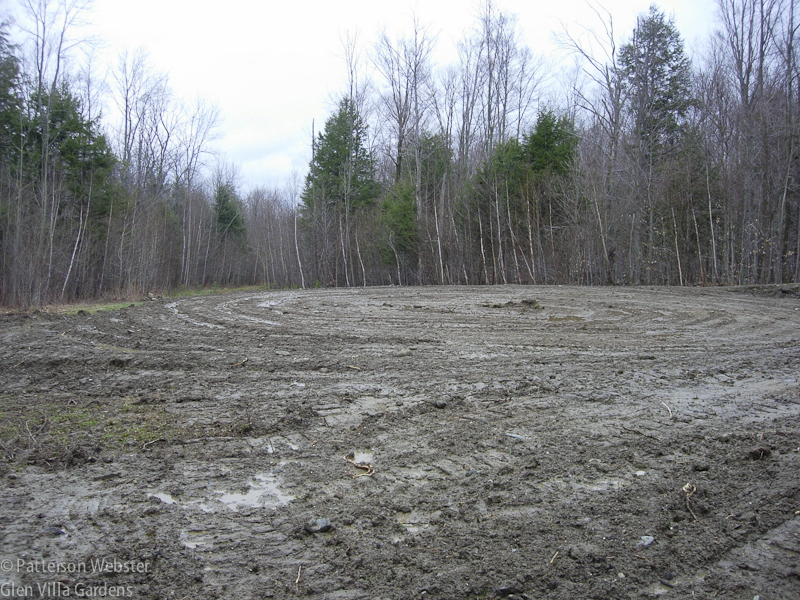

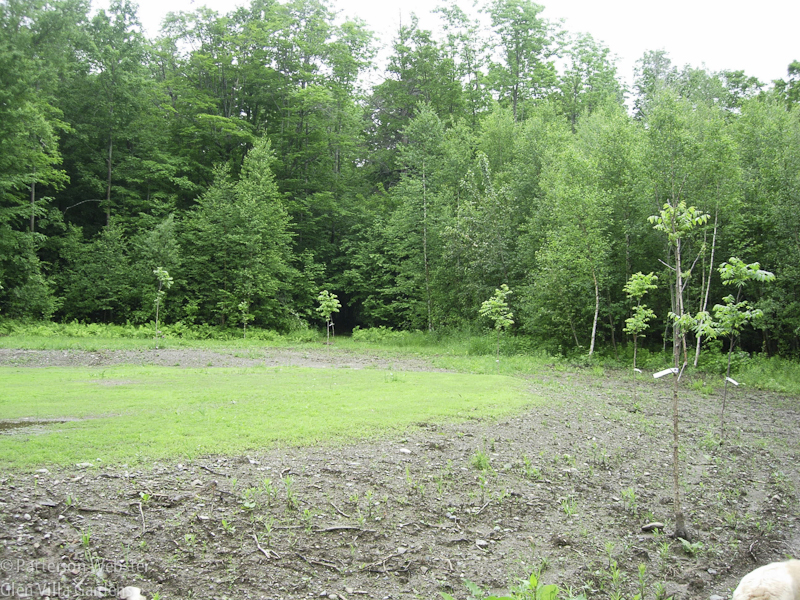
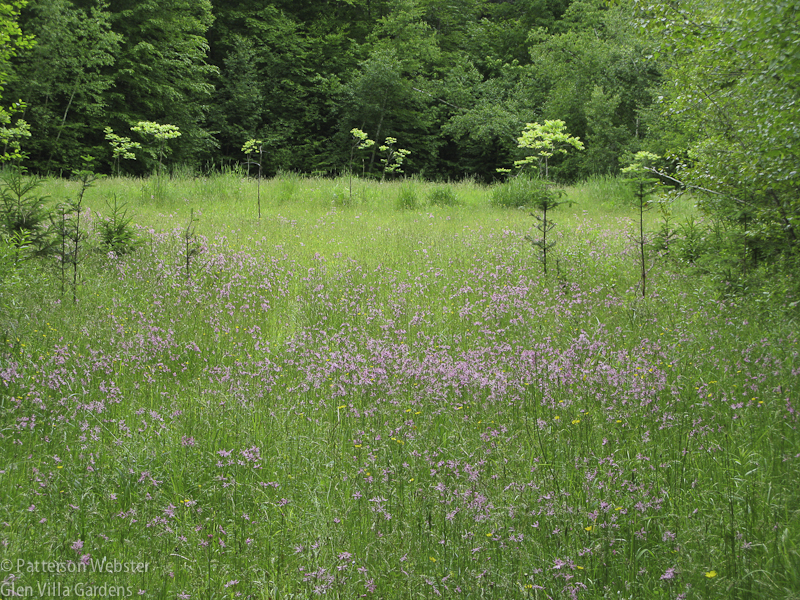
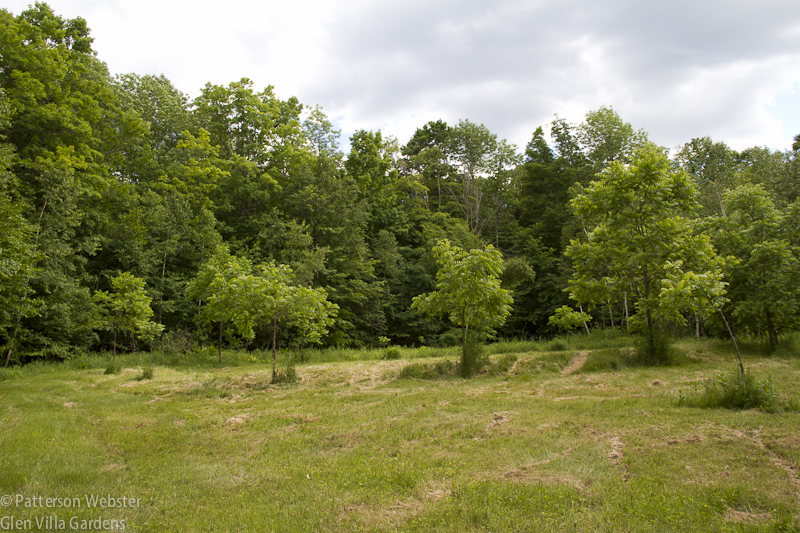
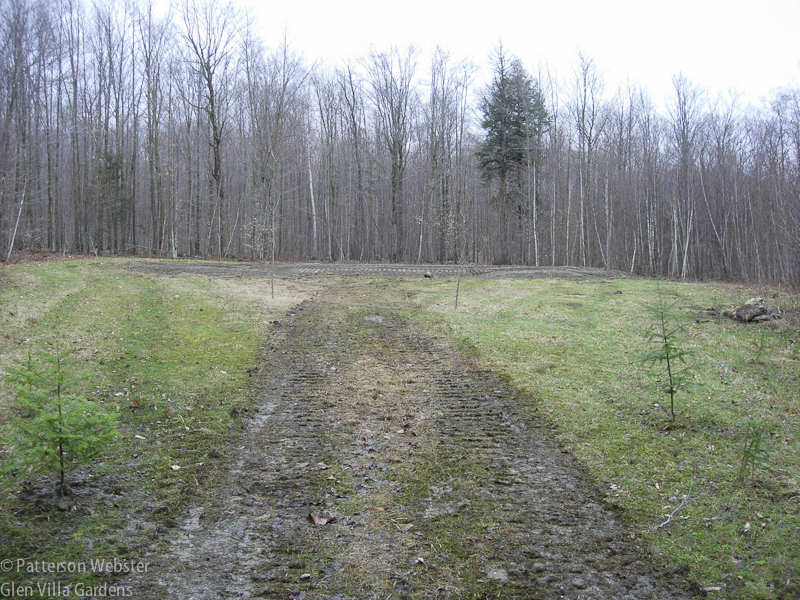





Glade skiing is alpine skiing through trees off-trail or on a defined woods trail.[1] Glades are variously sought for their solitude, beauty, or caches of ungroomed powder. Woods also tend to hold better snow longer thanks to the shade and shelter trees provide. Just thought I would toss this into the mix as well!
No alpine skiing possible in this (deliberately flattened) clearing. Cross country happens. Maybe our X-country trail should weave between the trees.
I think whenever you are editing the natural landscape, you are gardening at some level. You might call it woodlot management, or trail maintenance, or art installation, or landscape architecture, but it’s gardening in its most encompassing sense. In the wild areas of our property, I prune along the paths so that one can walk them without getting snagged. I’m not sure most people in my family are aware I do this. They may think the paths are just there. But I love paths; I have every since I was a child. They give me a sense of exploring without having to worry about being lost, a nice combination of adventure and safety. And I think I am gardening when I maintain them, even though it doesn’t look like a garden. It’s too bad you didn’t note the inspiration for the circle. If I know you, sooner or later there will be a sculpture in the middle of that circle–or perhaps a plaque set in the ground with a significant word inscribed on it.
Kathy, I agree, editing the natural landscape is gardening — i.e., it is a human act that shapes whatever is there, for whatever reasons. I’m glad to know that I’m not the only one who walks a path with clippers in hand, cutting back branches, dead or alive, that make the path less walkable.
I wish I could remember what inspired the circular planting. My guess is, simply because the circular space was there. And I’ve been thinking long and hard about what to do inside the circle, now that the trees are starting to have an impact. The question I’m asking myself is whether to put something inside the circle that will be looked at, or whether to make the circle a space for looking up and out. A word or two… you won’t be surprised to know I’m also considering that,
What you said about making the circle a space for looking up and out brought this to mind: There was a place in Les Quatre Vents specifically for laying on the grass and looking up at the sky. It was surrounded by trees (my notes say “arboreal stonehenge”), and fairly close to a screened gazebo where they had little concerts. Again, according to my notes, after laying there for a while, you would be unsure whether the clouds were moving and you were still, or the other way around.
I remember that place, Kathy. In fact, making the circle a place to look up at the sky is one of the things I’m thinking about. I need to make grass comfortable enough so that people want to lie on it, though, so am considering ways to do that without involving actual chairs or benches. Anyway, I’m glad you remembered that spot — I had totally forgotten about it. I’m guessing that James Turrell is the inspiration for the ‘arboreal stonehenge’ at Quatre Vents — certainly he specializes in finding ways to encourage sky gazing.
What an intriguing question. What makes a garden a garden? I guess I would go further than Kathy does in defining any editing of nature as gardening. A garden for me also has to include some creative/artistic intent or design. Your circle of trees seems to meet that threshhold — so, yes, I would consider it a garden.
I think that editing can be — probably has to be — a creative act. This morning, I looked at two very big birch trees growing on the hillside in the most heavily planted area of our garden, the place I call the Lower Garden. Trying to assess what was bothering me about the area, I decided that the trees needed to go; they are too tall and throw proportions out of whack. I’d love to edit them — but I doubt the rest of my family will agree!
As to whether the tree circle can be called a garden, I think the designer’s intent is key. I don’t remember why I wanted to plant them, and that failure of memory leaves me hanging. Clearly I intended to impose form on a natural setting, so for that alone I would agree, it is a garden. Not a flowery one, but a composed clearing.
My inclination is to agree with Grimm. A garden does not have to be tightly controlled to be a garden. Although if a caretaker thins out the trees in a wood, does that make it a garden. The caretaker has no aesthetic intent (probably), so is that different in intent enough to make the difference between a garden and a wood? I guess so, since otherwise a field of soybeans would also be a garden.
I agree with Grimm, too. And I like the quotation — I use it occasionally in talks.
I agree with Grimm, too. One of the criticisms of the work of Capability Brown was that his interventions in the landscape were so subtle it seemed nothing had been done at all. Aesthetic intent is the key, I believe. So do you think a field of soybeans arranged in some special way would then become a garden?
This is another way to ask the question I constantly ask, and have asked on my blog, but have yet to receive a satisfactory answer: What is a garden? I will have to read Grimm and ponder his philosophy
I think there is no single answer to the question, which is perhaps why all the answer we give ultimately fail to satisfy. Let me know if pondering Grimm provides any answers.